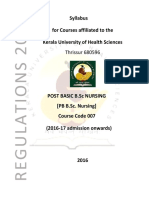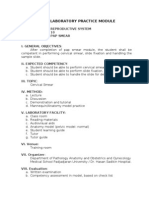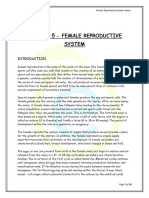Antepartum Hemorrhage
Antepartum Hemorrhage
Uploaded by
code-24Copyright:
Available Formats
Antepartum Hemorrhage
Antepartum Hemorrhage
Uploaded by
code-24Original Description:
Copyright
Available Formats
Share this document
Did you find this document useful?
Is this content inappropriate?
Copyright:
Available Formats
Antepartum Hemorrhage
Antepartum Hemorrhage
Uploaded by
code-24Copyright:
Available Formats
ANTEPARTUM HEMORRHAGE
Definition: Vaginal bleeding after 24 weeks of gestation
A 27 years old female, pregnant at 33 weeks of gestation presented to the ER with vaginal bleeding. How to
manage her?
NO PELVIC/RECTAL until previa ruled out
ABC's first: continuous fetal monitoring, intravenous access, Keep maternal oxygen saturation >95 percent,
Draw blood for a complete blood count, blood type and Rh, and coagulation studies, Notify the anesthesia
team
DDx:
Vasa previa
Placenta previa
Abruptio placenta
Uterine rupture
Bloody show
Cervical (cervicitis, polyp, cancer)
Vaginal (post-coital)
Non-gyne (hematuria, BRBPR)
Abruptio Placenta
Classification: concealed vs apparent
Presentation: pain with bleeding, pain is sudden/constant, localized to back and uterus, and Uterine
Contractions are usually high frequency and low amplitude, but a contraction pattern typical of labor
is also possible and labor may proceed rapidly
Risk Factors:
HTN, Preeclampsia/Pregnancy induced hypertension, Eclampsia.
Previous abruption
Large uterus (macrosomia, polyhydramnios, multiple gest)
EtOH, smoking, cocaine
Uterine anomaly
Trauma
Multiparity
Premature rupture of membranes
Chorioamnionitis
Consequences:
Maternal:
Excessive blood loss and DIC generally necessitate blood transfusion and can lead to
hypovolemic shock, renal failure, adult respiratory distress syndrome, multiorgan
failure, peripartum hysterectomy and, rarely, death.
Emergency cesarean delivery for fetal or maternal indications
Fetal and neonatal:
Perinatal morbidity and mortality related to hypoxemia, asphyxia, low birth weight,
and/or preterm delivery.
Fetal growth restriction (with chronic abruption).
DIAGNOSIS: The diagnosis is primarily clinical, but findings from imaging (retroplacental
hematoma).
Management:
Maternal stabilization
Severe abruption at any gestational age and nonsevere abruption at >36 weeks: Deliver.
Nonsevere abruption at 34 to 36 weeks (fetal status reassuring, maternal vital signs normal,
laboratory tests normal or mildly abnormal, mild to moderate bleeding): Deliver. Since these
patients remain at risk of developing a sudden severe abruption.
Minor abruption at 34 to 36 weeks: They should be monitored closely and delivered if they
have recurrent bleeding.
Nonsevere abruption at <34 weeks: Expectant management of abruption in pregnancies.
Corticosteroids to promote fetal lung maturation should be administered to pregnancies at 23
to 34 weeks of gestation, given the increased risk of need for preterm delivery
Recurrence risk: several-fold higher risk of abruption in a subsequent pregnancy
Placenta previa
Classification: partial vs complete vs marginal vs low-lying placenta
2
Presentation: In the second half of pregnancy, the characteristic clinical presentation is painless
vaginal bleeding.
Risk Factors:
Previous placenta previa
Previous cesarean delivery
Multiple gestation
Multiparity
Advanced maternal age
Infertility treatment
Previous abortion
Previous intrauterine surgical procedure
Maternal smoking, cocaine use.
Associated conditions:
Placenta accreta
Preterm labor and rupture of the membranes
Malpresentation
Intrauterine growth restriction
Vasa previa and velamentous umbilical cord
Congenital anomalies
Amniotic fluid embolism
DIAGNOSIS:
Sonographic determination of placental location before digital vaginal examination is
performed because palpation of the placenta can cause severe hemorrhage.
Echogenic homogeneous placental tissue covering or proximate to the internal cervical os (a
distance greater than 2 cm from the os excludes the diagnosis of previa).
Management:
ACUTE CARE:
Assessment:
Maternal: BP, HR, Urine output, estimation of vaginal blood loss (Soaked
pads)
Fetal: fetal heart rate
Intravenous access and crystalloid One or two large bore intravenous lines are
inserted and crystalloid is infused to achieve/maintain hemodynamic stability and
adequate urine output (at least 30 mL/hour).
Transfusion: begin red cell transfusions in hypotensive patients whose blood pressure
fails to improve after two liters of crystalloid have been rapidly infused.
Tocolysis: reduce or eliminate uterine contractions, which may promote placental
separation and bleeding. Prolong pregnancy and result in an increase in birthweight
Magnesium sulfate neuroprotection in patients with preterm (24 to 32 weeks) placenta
previa in whom a decision has been made to deliver within 24 hours, but not
emergently.
Antenatal corticosteroids A course of antenatal corticosteroid therapy should be
administered to symptomatic women between 23 and 34 weeks of gestation to
enhance fetal pulmonary maturity.
Admit and observe if: minimal bleeding, <36wks, fetus stable, no contractions
Indications for delivery Cesarean delivery is indicated if any of the following occur:
A nonreassuring fetal heart rate tracing unresponsive resuscitative measures
Life-threatening refractory maternal hemorrhage
Significant vaginal bleeding after 34 weeks of gestation
C/S if: previa unstable, fetal distress, >36wks
RECURRENCE: Placenta previa recurs in 4 to 8 percent of subsequent pregnancies
Vasa previa
Definition: fetal blood vessels are present in the membranes covering the internal cervical os. The
membranous vessels may be associated with a velamentous umbilical cord (membranous umbilical vessels at
the placental insertion site, no Wharton's jelly)
Presentation: painless bleeding, tachycardia, bradycardia, severe variables
Risk Factors:
Velamentous insertion of cord on low lying cervix
Diagnosis:
Ultrasonographic evidence of vasa previa
Painless vaginal bleeding upon rupture of membranes
4
Fetal heart rate abnormalities
Positive Apt, Ogita, or Loendersloot tests
Management:
Recommend inpatient observation starting at 32 weeks. Inpatient observation allows for emergent
caesarean in event of nonreassuring fetal testing, preterm labor, or preterm premature ruptured
membranes. Empiric delivery at approximately 35 weeks of gestation without confirmation of lung
maturity via amniocentesis is also recommended
Uterine rupture
Presentation: painful bleeding, during labour: suprapubic pain, contractions stop, vaginal bleeding,
hemoperitoneum
Risk Factors:
Prior uterine surgery
Trauma
Uterine distension (macrosomia, polyhydramnios, multiple gest)
Uterine anomolies
Choriocarcinoma, difficult labor (forceps, vag breech, shoulder
dystocia
Diagnosis: clinical
Management: two options: repair of the rupture site and hysterectomy
Complications of Antepartum Hemorrhage
Maternal
Shock
DIC
Anemia
C-section
Uterine atony > PPH
Hysterectomy
Death
Fetal
HR abnormalities
Hypoxia > Cerebral Palsy
Prematurity
Death
References:
CURRENT Diagnosis & Treatment: Obstetrics & Gynecology, 11e
Placental abruption: Clinical features and diagnosis (UPTODATE)
Placental abruption: Management (UPTODATE)
Clinical features, diagnosis, and course of placenta previa (UPTODATE)
Management of placenta previa (UPTODATE)
Velamentous umbilical cord insertion and vasa previa (UPTODATE)
Good Luck Dalal AlEesa
5
You might also like
- Michael W, COMAT ObgynDocument12 pagesMichael W, COMAT ObgynSeanNo ratings yet
- Instrumental Delivery 2016Document44 pagesInstrumental Delivery 2016vrunda joshiNo ratings yet
- Endometritis Unrelated To Pregnancy - UpToDateDocument9 pagesEndometritis Unrelated To Pregnancy - UpToDateLeoberto Batista Pereira SobrinhoNo ratings yet
- Incompetent NCPDocument1 pageIncompetent NCPJohn Francis Velasco100% (6)
- Seminar Antepartum HemorrhageDocument41 pagesSeminar Antepartum HemorrhageRaj JadhavNo ratings yet
- Antepartum Haemorrhage: Women's & Children's ServicesDocument4 pagesAntepartum Haemorrhage: Women's & Children's ServicesYwagar YwagarNo ratings yet
- Organizationalstructure FinalDocument49 pagesOrganizationalstructure FinalSudha YadavNo ratings yet
- Third Stage of LaborDocument32 pagesThird Stage of LaborWhirmey ChinyamaNo ratings yet
- 2017-05-08 007 PBBSc-1 PDFDocument123 pages2017-05-08 007 PBBSc-1 PDFSwapna josephNo ratings yet
- Kauvery Hospital:: Kauvery Medical Centre-2002 - KMC Speciality Hospital Has Named As Kauvery Hospital. 2004Document21 pagesKauvery Hospital:: Kauvery Medical Centre-2002 - KMC Speciality Hospital Has Named As Kauvery Hospital. 2004Sashi Kumar0% (1)
- EXTRAVASATIONDocument19 pagesEXTRAVASATIONphp_czarina04421No ratings yet
- Skill Laboratory Practice Module: Block: Reproductive System: 10 Topic: Pap SmearDocument5 pagesSkill Laboratory Practice Module: Block: Reproductive System: 10 Topic: Pap SmearMuthiana Rizky0% (1)
- Presentation1 Cervical BiopsyDocument14 pagesPresentation1 Cervical BiopsyChanta MaharjanNo ratings yet
- Uterine Displacement (Uterine Prolapse) : Presented By: Ms. Ankita Lal Lecturer Department of Obstetrics & GynecologyDocument7 pagesUterine Displacement (Uterine Prolapse) : Presented By: Ms. Ankita Lal Lecturer Department of Obstetrics & GynecologyPrincess LizaNo ratings yet
- Obstetrical EmergencyDocument41 pagesObstetrical EmergencyDrPreeti Thakur ChouhanNo ratings yet
- VVF Clinical Presentation 1Document24 pagesVVF Clinical Presentation 1georgeloto12No ratings yet
- 1.assignment On CPRDocument7 pages1.assignment On CPRsantosh kumarNo ratings yet
- 001hypertensive Disorders in Pregnancy PDFDocument23 pages001hypertensive Disorders in Pregnancy PDFRosechelle Bas SamsonNo ratings yet
- Prepared By: Aashma Bidari M.Sc. Nursing, 1 Year KusmsDocument68 pagesPrepared By: Aashma Bidari M.Sc. Nursing, 1 Year KusmsAasma BidariNo ratings yet
- Assisting in Papanicolaou SmearDocument13 pagesAssisting in Papanicolaou SmearRika Mae100% (1)
- Poly Hydro MN IosDocument21 pagesPoly Hydro MN IosAsimNo ratings yet
- A Study To Evaluate The Effectiveness of Planned Teaching Programme On Knowledge Regarding Tracheostomy Care Among Final Year GNM Students in Selected Schools of Nursing at Bagalkot, KarnatakaDocument9 pagesA Study To Evaluate The Effectiveness of Planned Teaching Programme On Knowledge Regarding Tracheostomy Care Among Final Year GNM Students in Selected Schools of Nursing at Bagalkot, KarnatakaInternational Journal of Innovative Science and Research TechnologyNo ratings yet
- Presentation Aids and HivDocument27 pagesPresentation Aids and HivLamnunnem HaokipNo ratings yet
- Staffing Pattern For CollegeDocument5 pagesStaffing Pattern For CollegeAndrea DiazNo ratings yet
- Nursing Education in IndiaDocument34 pagesNursing Education in IndiaRajesh SharmaNo ratings yet
- Psychiatric EmergenciesDocument25 pagesPsychiatric EmergenciesAnnapurna DangetiNo ratings yet
- Phototherapy On The Postnatal WardDocument5 pagesPhototherapy On The Postnatal WardYwagar Ywagar100% (1)
- Nursing Regulatory MechanismDocument26 pagesNursing Regulatory MechanismPema ChuklaNo ratings yet
- Preterm Labour & Premature Rupture of Membrane: Dr. Mashael Shebaili Consultant Ob/Gyn Assistant ProfessorDocument27 pagesPreterm Labour & Premature Rupture of Membrane: Dr. Mashael Shebaili Consultant Ob/Gyn Assistant ProfessorarajorgeNo ratings yet
- Ectopic Pregnancy: Definition: An Ectopic Pregnancy Is One in Which The Fertilized Ovum IsDocument4 pagesEctopic Pregnancy: Definition: An Ectopic Pregnancy Is One in Which The Fertilized Ovum IsSuhas IngaleNo ratings yet
- Basic Nursing:Foundations of Skills & Concepts: Diagnostic TestsDocument41 pagesBasic Nursing:Foundations of Skills & Concepts: Diagnostic TestsellaguraNo ratings yet
- Submitted by Balkeej Kaur MSC 1 Year Acon, Sri Muktsar SahibDocument41 pagesSubmitted by Balkeej Kaur MSC 1 Year Acon, Sri Muktsar SahibmalathiNo ratings yet
- Research in Continuing EducationDocument2 pagesResearch in Continuing EducationAchademaatram Molu100% (2)
- Independent Nurse Practice ANPDocument14 pagesIndependent Nurse Practice ANPSamjhana NeupaneNo ratings yet
- Vision and MissionDocument24 pagesVision and MissionMonika JosephNo ratings yet
- Final - Analgesia and Anaesthesia in Labor-FinalDocument22 pagesFinal - Analgesia and Anaesthesia in Labor-Finalnathsujitkr1980100% (1)
- Unit Plan IIIDocument7 pagesUnit Plan IIISuji MerlineNo ratings yet
- Preparation OF Group Work: Netaji Subhash College of NursingDocument7 pagesPreparation OF Group Work: Netaji Subhash College of NursingDimpal ChoudharyNo ratings yet
- Procedure Right Onplacental ExaminationDocument3 pagesProcedure Right Onplacental ExaminationPriyanka SheoranNo ratings yet
- MS ObgyDocument18 pagesMS ObgySushantaNo ratings yet
- IUGRDocument6 pagesIUGRabhagaurNo ratings yet
- Arising To The Challenge: Zambia Nurses and Midwives Success StoryDocument16 pagesArising To The Challenge: Zambia Nurses and Midwives Success StoryMiriward Zimba100% (1)
- Guidelines-For-Bsc - New. Physical StructureDocument15 pagesGuidelines-For-Bsc - New. Physical Structurepriyanka bhavsarNo ratings yet
- Preparation of Organizational ChartDocument6 pagesPreparation of Organizational ChartAjay DNo ratings yet
- 2 Foetal Development and CirculationDocument7 pages2 Foetal Development and CirculationJay PaulNo ratings yet
- ON Hemorrhage in Late Pregnancy, Placenta Previa and Abruptio PlacentaDocument22 pagesON Hemorrhage in Late Pregnancy, Placenta Previa and Abruptio PlacentaReshma AnilkumarNo ratings yet
- Nursing Care PlanDocument9 pagesNursing Care PlanBishwajitMazumderNo ratings yet
- Related Protocols / Related Links Include:: Lumbar Puncture in The NeonateDocument7 pagesRelated Protocols / Related Links Include:: Lumbar Puncture in The NeonateJairo Camilo Guevara FaríasNo ratings yet
- Con Mission, Vision, ObjectivesDocument1 pageCon Mission, Vision, ObjectivesMelchor Felipe SalvosaNo ratings yet
- Master RotationDocument3 pagesMaster RotationNisha MwlzNo ratings yet
- Physiology of Lactation: Prepared By: Fy MSC NursingDocument32 pagesPhysiology of Lactation: Prepared By: Fy MSC NursingSùjâl PätídàrNo ratings yet
- Induction of LabourDocument51 pagesInduction of LabourSarita PariyarNo ratings yet
- Cardiac EmergenciesDocument73 pagesCardiac EmergenciesKristine CaringalNo ratings yet
- Planning Equipment's and Supplies For Nursing CareDocument41 pagesPlanning Equipment's and Supplies For Nursing CareSimon JosanNo ratings yet
- CordocentesisDocument14 pagesCordocentesisMunnur Tharun KumarNo ratings yet
- Ure Thro CeleDocument3 pagesUre Thro CeleKusum RoyNo ratings yet
- Post Partum Haemorrhage-1Document29 pagesPost Partum Haemorrhage-1medical chroniclesNo ratings yet
- Ward Teaching ON Hiv in PregnancyDocument14 pagesWard Teaching ON Hiv in PregnancySulochanaNo ratings yet
- Psychological and Social Aspect of MenopauseDocument16 pagesPsychological and Social Aspect of MenopauseFarheen khanNo ratings yet
- Drugs in ObgDocument41 pagesDrugs in ObgkishorNo ratings yet
- CORDOCENTESISDocument6 pagesCORDOCENTESISSagar HanamasagarNo ratings yet
- Role of Dietary Fibers and Nutraceuticals in Preventing DiseasesFrom EverandRole of Dietary Fibers and Nutraceuticals in Preventing DiseasesRating: 5 out of 5 stars5/5 (1)
- PROLOG: Obstetrics, Ninth Edition (Assessment & Critique)From EverandPROLOG: Obstetrics, Ninth Edition (Assessment & Critique)No ratings yet
- Identity All Good Things Hart of Dixie: S01E02 (End) "Two Thousand Stones" S01E03 (End) S01E04 (Start) S01E07 "I Should've Kissed U" S01E09 (End) S01E19 (Scotty Mcreery) + (End)Document1 pageIdentity All Good Things Hart of Dixie: S01E02 (End) "Two Thousand Stones" S01E03 (End) S01E04 (Start) S01E07 "I Should've Kissed U" S01E09 (End) S01E19 (Scotty Mcreery) + (End)code-24No ratings yet
- Form UCE 3 Participation AssessmentDocument1 pageForm UCE 3 Participation Assessmentcode-24No ratings yet
- AbbreviationsDocument7 pagesAbbreviationscode-24No ratings yet
- Mentoring ProgramDocument1 pageMentoring Programcode-24No ratings yet
- 2-Year Pre-Professional Program Study Plan 2008Document5 pages2-Year Pre-Professional Program Study Plan 2008code-24No ratings yet
- Form UCE 10: Clinical Attachment Performance Feedback: DD MM DD MMDocument1 pageForm UCE 10: Clinical Attachment Performance Feedback: DD MM DD MMcode-24No ratings yet
- Antenatal Care (ANC)Document77 pagesAntenatal Care (ANC)tareNo ratings yet
- APH DR DaudDocument56 pagesAPH DR DaudMohd Daud Che YusofNo ratings yet
- AttachmentDocument39 pagesAttachmentshmlniz100% (1)
- Uterine Sub InvolutionDocument1 pageUterine Sub Involutionkrystle0875% (4)
- OBGYN Invasive Cervical Cancer ArticleDocument7 pagesOBGYN Invasive Cervical Cancer ArticleVanessa HermioneNo ratings yet
- The Simple Solution For Postpartum HemorrhageDocument49 pagesThe Simple Solution For Postpartum HemorrhageSara CookNo ratings yet
- AUB Patofisiologi and DefinisionDocument36 pagesAUB Patofisiologi and Definisionindahmahfuzhah100% (2)
- Uterine Fibroid and HomoeopathyDocument9 pagesUterine Fibroid and HomoeopathyDr. Rajneesh Kumar Sharma MD HomNo ratings yet
- Questions and Answers in Maternal and Health NyrsingDocument10 pagesQuestions and Answers in Maternal and Health Nyrsingreden14No ratings yet
- Obesteric Gynacology Short Notes For Usmle Step 2Document32 pagesObesteric Gynacology Short Notes For Usmle Step 2Rodaba Ahmadi Meherzad100% (1)
- Abnormal Uterine Bleeding - PresentationDocument76 pagesAbnormal Uterine Bleeding - PresentationlookNo ratings yet
- OBG 3rd & 4th NovDocument370 pagesOBG 3rd & 4th NovirukusenseiNo ratings yet
- Hype Re Me SisDocument28 pagesHype Re Me SisLyn VillabrozaNo ratings yet
- MCQDocument4 pagesMCQleonNo ratings yet
- FemrepnotesDocument38 pagesFemrepnotesLibi FarrellNo ratings yet
- Placenta PreviaDocument1 pagePlacenta PreviaIris De LeonNo ratings yet
- Councelling and History TakingDocument5 pagesCouncelling and History TakingbashingarNo ratings yet
- The Syllabus of OB - GYNDocument1 pageThe Syllabus of OB - GYNمنوعاتNo ratings yet
- AbortionsDocument99 pagesAbortionsAGERI PUSHPALATHANo ratings yet
- MOH Obstetrics Managment Protocol PDFDocument228 pagesMOH Obstetrics Managment Protocol PDFmaezu100% (2)
- Cervical CancerDocument7 pagesCervical CancerChristine Joy Clemente BerjaNo ratings yet
- GTG 67 Endometrial HyperplasiaDocument31 pagesGTG 67 Endometrial HyperplasiaFinka Inarae100% (1)
- 3 31 67Document37 pages3 31 67jikah88996No ratings yet
- 9 - Clinical Management (STRATOG 2015 SBAs)Document12 pages9 - Clinical Management (STRATOG 2015 SBAs)w yNo ratings yet
- Post Op InstructionsDocument12 pagesPost Op Instructionssammyjo12No ratings yet
- Yale - Abnormal Uterine Bleeding Preceptor - 389620 - 284 - 45546 - v1Document12 pagesYale - Abnormal Uterine Bleeding Preceptor - 389620 - 284 - 45546 - v1omegasauron0gmailcomNo ratings yet
- SOAL UJIAN MCQ Jan 2022Document22 pagesSOAL UJIAN MCQ Jan 2022densus awNo ratings yet































































































